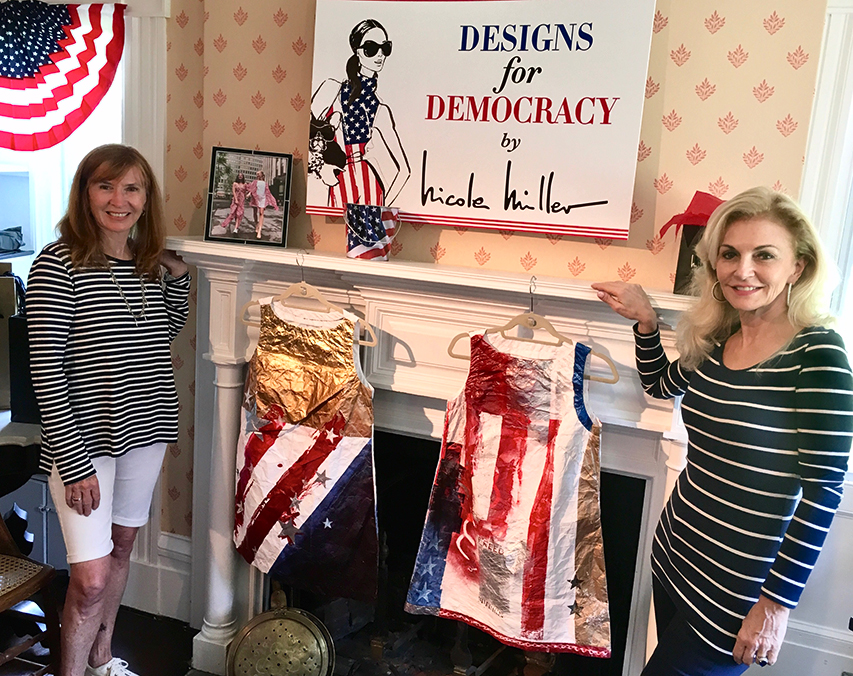Nicole Miller Cares, U Should Too

When Melania Trump recently wore the world’s most inappropriate jacket on her trip to a child detention center (“I don’t really care, do u?” it read), jacket-gate erupted in a firestorm of speculation, denunciation, and defense as the world tried feverishly to decipher the first lady’s fashion message.The power of fashion in politics is nothing new to Nicole Miller, the American fashion designer who has been in business since 1982, and whose pop-up shop featuring her Designs for Democracy collection is currently open at the Bridgehampton Museum. The clothes, in a variety of subtly patriotic colors and prints, are part of an ongoing exhibition by the Museum of Democracy, a roving archive of perhaps the world’s largest collection of presidential memorabilia, from George Washington to the present day. Amassed over four decades by the late Jordan M. Wright, a lawyer and magazine publisher who began collecting Robert F. Kennedy buttons in 1968 as a 10-year-old, the collection grew, as did his fascination. Only a fraction of its million-plus objects are on display until Labor Day in “Boats, Barns, and Bootlegging” at the William H. Corwith House, the home of the Bridgehampton Museum on Main Street. The exhibition chronicles Long Island’s colorful stories of bootleggers, rumrunning vessels, and speakeasies during Prohibition from 1920 to 1933.Ms. Miller’s shop is set up in one of the parlor rooms at the front of the circa 1825 house, and is festooned with banners of stars and stripes. Her clothes, which include a few pieces exclusively designed for the exhibition, offer something for everyone: flirty and flowing cocktail dresses, lacy zip-up jackets, ruffled blouses, pared-down essentials, sunglasses, and one-piece swimsuits with her signature pleating, which, she said, “everyone loves because it hides just about anything.”During the 1980s and ’90s, Ms. Miller was known for her daring prints, especially those on her collection of men’s neckties, which became wacky conversation pieces featuring before-and-after sketches of plastic-surgery procedures, Elvis, slot machines, African masks, and wild animals. While her sense of fun and daring is still evident in her colorfully printed dresses and beach cover-ups available at the museum shop, her boldest statement on sale in Bridgehampton is undoubtedly two hand-painted paper dresses resembling the infamous wearable paper mini-dresses from the 1968 presidential election, featuring Robert F. Kennedy’s face on one and a red stenciled “Nixon” on the other.Ms. Miller’s political paper dresses are made from Tyvek, a synthetic material spun out of polyethylene fibers and generally used to protect buildings during construction. The designs are bold brushstrokes of stars and stripes; one has a chain-link design painted across the hemline, with the words “freed” and “united” on the dress. Unlike the first lady’s cryptic message on her jacket, Ms. Miller’s stand on justice and egalitarianism is evidently clear. Fashion has always been an agent of change, but now, in this designer’s hands, these changes seem benevolent. One of the two Tyvek dresses sold on Saturday for approximately $1,500. Proceeds will benefit the Bridgehampton Museum and the Museum of Democracy.The rest of the ground floor of the museum contains paraphernalia from the Museum of Democracy’s world-class political archive and from the archive of the Bridgehampton Museum. As such, “Boats, Barns, and Bootlegging” is a must-see, dense, and deeply fascinating display that tells the story of Long Island during America’s “dry” years, when it was illegal to produce, transport, or sell alcoholic beverages in the country. But the coves and crannies of Long Island’s shores and its proximity to New York City made it a hotbed of illicit importing from Canada, the Caribbean, and Europe.There is wonderful material here, including buttons, flags, posters, clothing, an Art Deco-era liquor cabinet, and photographs. The items are jointly from the Wright family collection and the Bridgehampton Museum’s archives.A strangely draconian poster shows the nine steps of “The Drunkards Progress: From the First Glass to the Grave,” a half-circle of male figures beginning with step one, “A glass with a friend,” and ending in step nine, “Death by suicide.” Under the semicircle is an image of a weeping woman walking with a child. It was all part of the temperance movement, an organized effort to encourage abstinence from alcohol.Reproductions of The Star from this time period are also on display. One such issue, from Jan. 2, 1931, tells of East Hampton and Amagansett speakeasies being raided and contains the headline “Solid Shot Stops Fleeing Rum Boat,” under which is a story of a British boat captured in Montauk carrying 2,800 burlap sacks of bottled whiskey and champagne.There are delightfully humorous reminders of the jubilation that followed Prohibition’s repeal in 1933. In a photograph, a billboard sits atop a car — “Happy Days Are Beer Again” it reads. Another, a small fabric swatch, pleads, “More Beer, Less Taxes.” This is the second year that the Bridgehampton Museum has teamed up with the Museum of Democracy for a show, and the first time Ms. Miller has opened a shop as part of an exhibition. Pamela Wright co-founded the Museum of Democracy in 2006 with her husband, and now runs the nonprofit organization along with her son and daughter, after her husband died unexpectedly in 2008. Busy setting up the display with Julie Greene, the Bridgehampton Museum’s curator and archivist, before the show’s opening earlier this month, she seemed thrilled to continue her late husband’s mission of chronicling the twists and turns of America’s history through this living, breathing history of the democratic tradition. The exhibit takes on particular relevance during these times when events in this country and around the world appear to have tested the limits of people’s faith in democracy.
